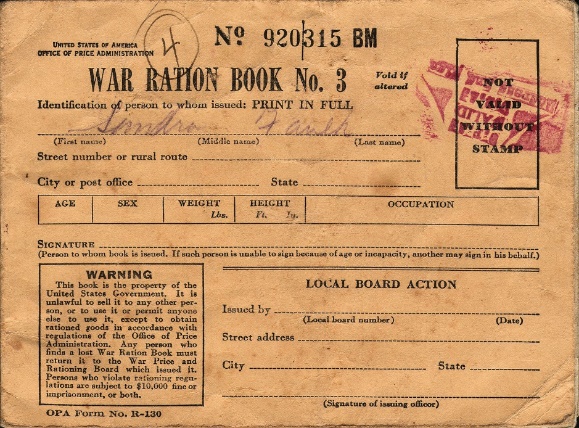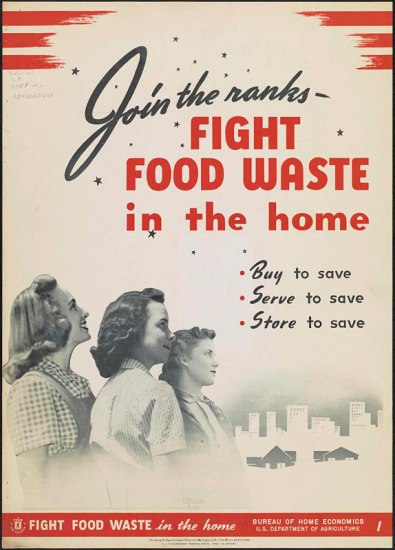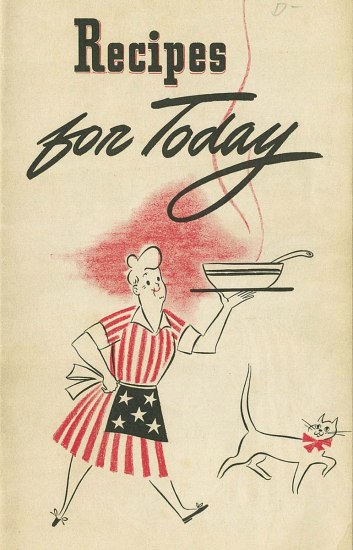This 75th Anniversary lookback article originally ran in the October 2018 edition of the All Fairlington Bulletin.
Fairlingtonians today have a myriad of food and eating choices: From grocery and convenience stores to a farmers’ market and from fast food and take-out to cafes, diners, and restaurants, all within a short distance. This plethora of choices would have astounded Fairlington’s first residents, who lived in a brand-new community with no surrounding commercial activity – and with wartime rationing.

Following the attack on Pearl Harbor in 1941, the Office of Price Administration established several thousand boards of local volunteers to administer a national rationing system. Tires, soon in short supply as Japan conquered the rubber production regions of southeast Asia, were the first item on the list. Sales of automobiles were ended in 1942, with only doctors and clergy qualified by purchase new cars. As factories shifted to production of tanks, weapons, and military supplies, additional items were added to the list: typewriters, bicycles, metal office furniture, radios, phonographs, refrigerators, vacuum cleaners, and washing and sewing machines.

Food rationing and the distribution of ration books also began in 1942. Each person in a household received one through schools, PTAs, and other voluntary organizations. Sugar was the first commodity to be rationed but, by 1943, the list had grown to include meat, lard, shortening, food oils, cheese, butter, margarine, processed foods, dried fruits, canned milk, jams, jellies, and fruit butter. 1
Even with the rationing system in place, some commodities remained in short supply. Feeding a family required careful planning and inventive approaches. Cookbooks appeared to guide homemakers, many of which are held in the Product Cookbook Collection at The Smithsonian Institution (SI). A few years ago, staff from SI’s Patrick F. Taylor Object Project, experimented with these recipes.

“We noticed that the chipper tone of these ration cookbooks reassures home cooks that they can make tasty meals with limited ingredients… General Foods Corporation’s Recipes for Today, published in 1943, takes an enthusiastic, patriotic tone in describing creative fixes and substitutions for rationed ingredients. The section “Cheer for Lunch Boxes” declares that “war-working lunches must offer good square meals.” 2
Here is an example of a ‘war cake’3 made without butter, eggs, or milk:
- 2 cups castor sugar
- 2 cups hot water
- 2 Tbsp lard
- 1 teaspoon salt
- 1 teaspoon cinnamon
- 1 teaspoon cloves
- 1 package seedless raisins.
Boil all together. After cold, add 2 cups of flour, 1 teaspoon of baking soda dissolved in 1 teaspoon hot water. Bake about one hour in a slow oven (300-325°F).
Give it a try! But, you might want to add an egg.
-
Lee Kennett, For the duration…: the United States goes to war, Pearl Harbor-1942. New York: Scribner, 1985. Sugar: U. S. consumers register for first ration books”. Life. 1942-05-11. Robert James Maddox. The United States and World War II. New York: Routledge, 2018. ↩︎
-
Caitlin Kearney. Smithsonian Institution Taylor Foundation Object Project Blog. April 1, 2016. ↩︎
-
Jaya Saxena. Making “War Cake,” a Remnant of WWII Rationing. Eating History Blog, New-York Historical Society, November 6, 2014. ↩︎